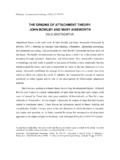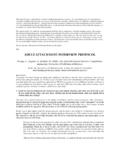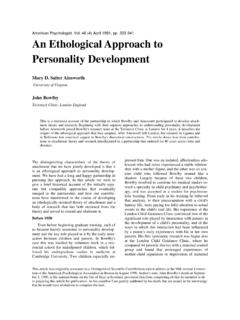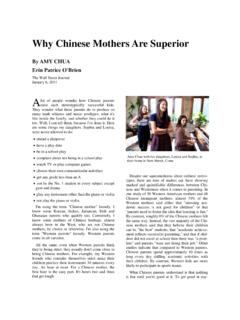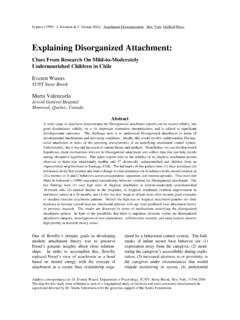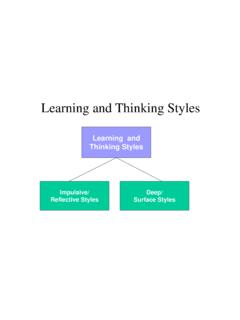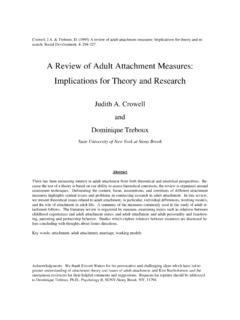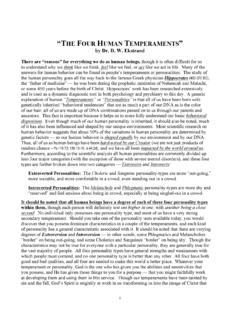Transcription of Attachment and Socialization - Stony Brook
1 The belief that child -parent Attachment plays an im-portant role in social development occupies center stage in most contemporary theories of childhood Socialization . The origins of this belief are easily traceable to Freud's emphasis on the significance of infant-mother Attachment for virtually all aspects of subsequent personality development. Its endurance over the intervening decades has been sustained by a wealth of empirical data linking Attachment to a wide range of Socialization outcomes in both childhood and adulthood (Waters, Hay, & Richters, 1986). Included among these are patterns of social com-petence (Waters, Wippman, & Sroufe, 1979), proso-cial behavior (Lieberman, 1977), antisocial behavior (Sroufe, 1983), and behavior problems (Erickson, Sroufe, & Egeland, 1985) in early childhood.
2 In ad-dition, the major longitudinal studies of delinquent and criminal behavior have consistently documented links between family factors and subsequent antiso-cial behavior (Glueck & Glueck, 1950; McCord & McCord, 1959; West & Farrington, 1977). Promi-nent among these have been parental characteristics such as lack of warmth, poor supervision, inconsis-tency, and poor child -rearing practices - factors that have been demonstrated in more recent studies to be associated with anxious child -parent Attachment (Ainsworth, Blehar, Waters, & Wall, 1978). Ironically, the mechanisms of anaclitic and de-fensive identification proposed by Freud to explain the association between Attachment and Socialization have largely been invalidated by empirical research.
3 More-over, they have not been replaced in Bowlby's (1969, 1973, 1980) more recent ethological attach-ment theory by alternative explanatory constructs. Bowlby himself has long had an interest in the asso-ciation between Attachment and antisocial behavior, and his theory provides a rich source for speculation about Attachment and Socialization . Moreover, Bowlby accepts the basic premise that children un-wittingly identify with-in the sense of modeling themselves after-their parents in the normal course of development. Nonetheless, ethological Attachment theory posits no formal mechanism(s) through which child -parent Attachment might explain the emergence of antisocial behavior; the link remains very much an association in search of an explanation.
4 The primary aim of this chapter is to rekindle among Socialization researchers an interest in child -parent Attachment as a powerful and perhaps decisive factor in the Socialization process. In the first section we address ourselves in considerable detail to the role posited for Attachment in both psychodynamic and more contemporary social learning/cognition views of Socialization . Our emphasis is on the chief limitations of each in accounting for the emergence and stability of prosocial and antisocial behavior within In the second section we employ a social influ-ence perspective to integrate the best features of each model into a single theoretical framework that em-phasizes the role of child -parent Attachment .
5 Within the context of this framework we introduce and dis-cuss a revised ( , non-Freudian) concept of child -parent identification as a mediating process to ac-count for the Attachment - Socialization link. In the final section we highlight features of this model that diverge from and complement existing models of Socialization , with emphasis on its heuris- Attachment and Socialization The Positive Side of Social Influence JOHN E. RICHTERS AND EVERETT WATERS Richters, J. & Waters, E. (1991). Attachment and Socialization : The positive side of social influence. In Lewis, M. & Feinman, S. (Eds), Social influences and Socialization in infancy.
6 (pp. 185-214). NY: Plenum Press. When one considers values in general and moral values in particular from a cognitive standpoint. one is faced with the same problem. Cognition does not offer the principle of determination, of preference, of value. (Loevinger, 1976, ) 2 Richters & Waters tic value for guiding and interpreting future sociali-zation research. Two Models of Socialization Among the most enduring of Freud's legacies to psychology have been his insights regarding the na-ture, significance, and interrelatedness of early at-tachment relationships and Socialization outcomes.
7 Indeed, early child -parent Attachment and the course of Socialization are virtually inseparable within psy-choanalytic theory. It is somewhat ironic, therefore, that the research traditions engendered by Freud's insights-namely, Attachment and Socialization - have proceeded by and large along separate trajectories. As a consequence of this separation, much of what we currently know about childhood Socialization has accumulated outside of a unitary theoretical frame-work for interpreting its relevance to issues of at-tachment. We are left instead with two essentially different models of childhood Socialization : Freud's psychoanalytic theory, and the more recent social learning and cognition perspectives.
8 These perspec-tives represent not only different viewpoints on so-cialization, but distinct historical periods as well. Therefore, our review of existing models in the fol-lowing section is organized both thematically and chronologically. Contemporary views have been shaped considerably by earlier failures of psychoana-lytic theory in the empirical realm, and there is much to be gained through an understanding of how and why they arrived at the roles they posit for attach-ment. Psychoanalytic Perspective Attachment The central importance of child -parent attach-ment in Freud's theory of personality is perhaps best captured in his characterization of the infant-mother relationship as ~ without parallel, established unal-terably for a lifetime as the first and strongest love object and as the prototype of all later love relation-ships" (Freud, 1940/1949, ).
9 This prototype not only forms the matrix on which subsequent personal-ity development builds, according to Freud, but also provides the motivational core of a great deal of be-havior throughout the lifespan. Moreover, the con-flicts and defenses rooted in early Attachment rela-tionships continue to assert themselves throughout life in the form of various prosocial and antisocial behavior patterns. Identification Socialization was described by Freud as the proc-ess(es) through which a child 's natural erotic and ag-gressive instincts are gradually brought under the control of the superego. Subsequently, socially unac-ceptable expressions of these instincts are prevented and/or punished by the superego.
10 Moreover, Freud believed that the superego's characteristic patterns of influence on behavior are formed quite early in life, and remain substantially unchanged throughout the lifespan. Identification within psychoanalytic theory means much more than a simple imitation of parental be-haviors. The superego, in Freud's own term, repre-sents the precipitate" of parental influence (Freud, 1940/1949, ). In particular, Freud believed that children identify with the superegos as well as the situational behaviors of their parents. As such, they are influenced not only by parental personalities, but also by familial, cultural, and societal values and standards reflected in those personalities.
